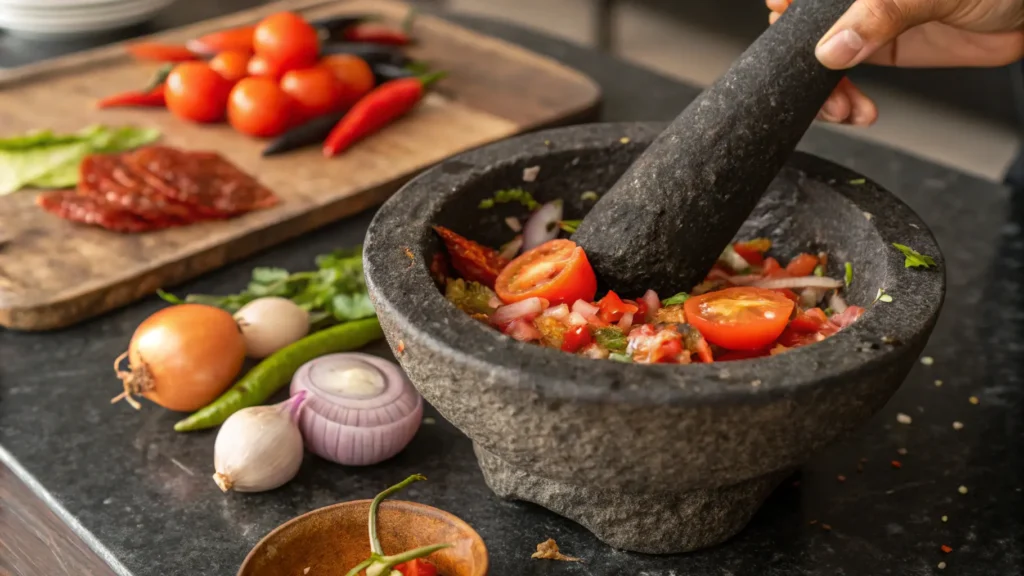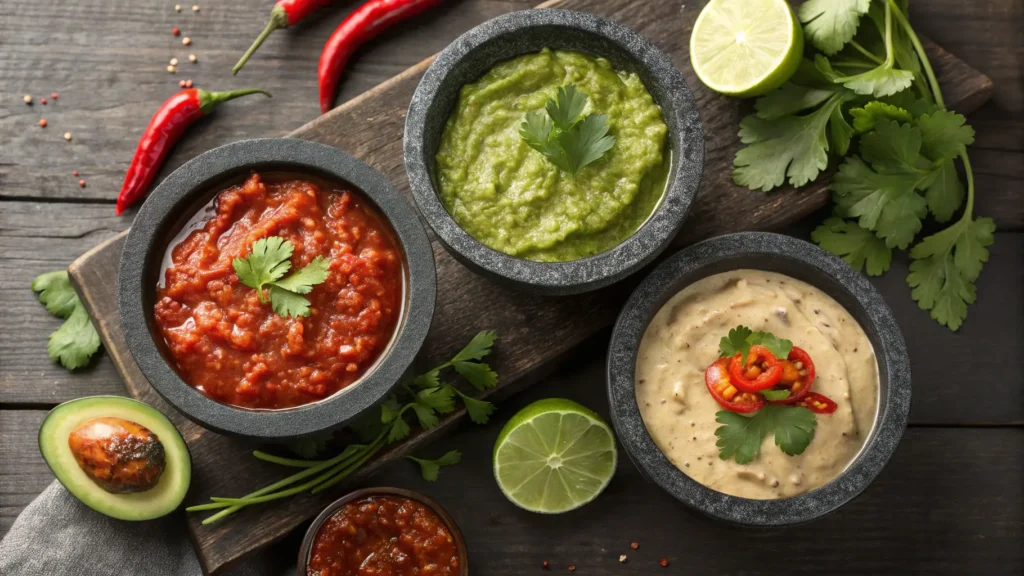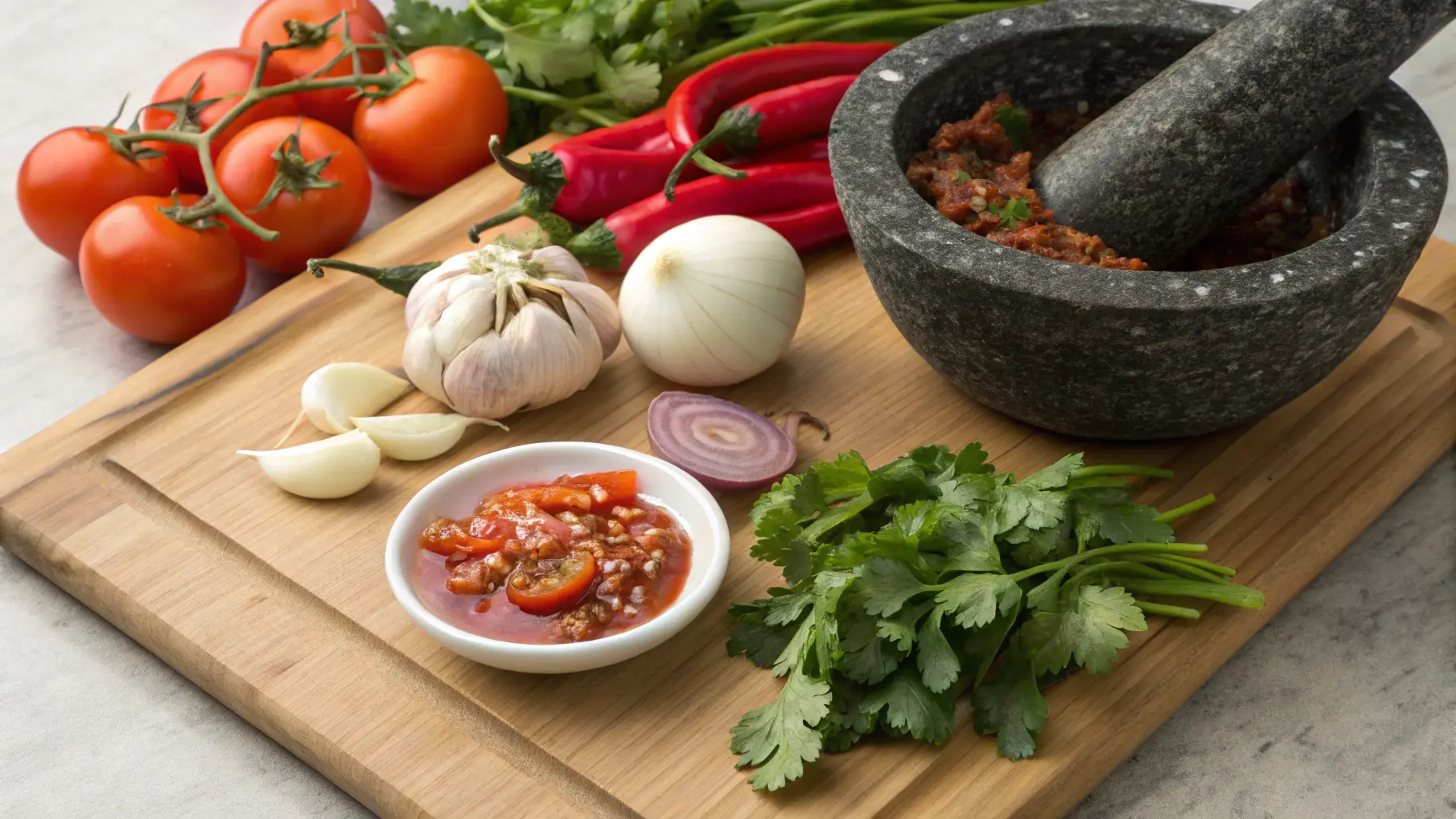Preparing a Molcajete Sauce
Molcajete sauce is a traditional Mexican salsa made by grinding fresh, flavorful ingredients in a molcajete, a stone mortar and pestle. Typically, it includes roasted tomatoes, garlic, onions, cilantro, and chili peppers, creating a rich and smoky sauce. Known for its vibrant taste and rustic texture, molcajete sauce adds authentic flavor to tacos, grilled meats, and many other Mexican dishes.
Table of Contents
What Is Molcajete Sauce?
Defining Molcajete Sauce
Molcajete sauce is a quintessential Mexican condiment prepared using a molcajete, a traditional volcanic stone mortar and pestle. This sauce is celebrated for its bold, rustic flavors and versatile uses in Mexican cuisine. Unlike blended sauces, it offers a chunky texture that highlights each ingredient’s natural essence.
Typically, the sauce combines roasted vegetables, spices, and herbs, with the grinding process unlocking aromatic oils and flavors, making it a cornerstone of authentic Mexican meals.
Its Importance in Mexican Cuisine
Molcajete sauce is more than just a condiment—it is a cultural symbol that reflects the heritage of Mexican cooking. Often made during family gatherings or festive occasions, it brings together tradition and community. Its vibrant flavors enhance tacos, grilled meats, and seafood, adding a distinctive touch to every dish.
Origin and History of Molcajete Sauce
Traditional Roots in Mexican Culinary Culture
The molcajete itself has origins tracing back to Mesoamerican times. Used by the Aztecs and Mayans, this tool was integral to grinding spices and preparing salsas. Over centuries, Molcajete sauce has evolved, incorporating regional ingredients and techniques while staying true to its roots.
How the Molcajete Shapes the Sauce’s Flavor
The coarse volcanic stone of the molcajete adds a unique flavor profile to the sauce. Unlike metal blades in blenders, the grinding action gently releases the oils and natural juices of ingredients without heating them. This process enhances the smoky, earthy flavors that define Molcajete sauce.
The Role of the Molcajete in the Recipe
Grinding Versus Blending
While modern appliances like blenders and food processors are quicker, they lack the ability to create the chunky texture and layered flavors achieved with a molcajete. Grinding by hand ensures that every ingredient is evenly incorporated while maintaining its distinct characteristics.
How Texture Enhances the Sauce’s Taste
The uneven consistency of Molcajete sauce is what sets it apart. Chunks of roasted tomatoes, bits of charred chiles, and crushed garlic deliver bursts of flavor in every bite. The texture not only provides visual appeal but also enhances the sauce’s overall depth.
Essential Ingredients in Molcajete Sauce

Core Vegetables
Tomatoes or Tomatillos
At the heart of Molcajete sauce are roasted tomatoes or tomatillos, depending on the recipe. Tomatoes lend a rich, sweet base for salsa roja, while tomatillos provide the tangy foundation for salsa verde.
Garlic and Onion
These aromatics are roasted until charred, adding depth and a hint of smokiness to the sauce. Their roasted flavor creates a savory balance against the acidity of tomatoes or tomatillos.
Chili Peppers
Types of Chilies Used
The choice of chiles dramatically influences the sauce’s heat and flavor profile. Popular options include:
- Jalapeño: Mild and earthy.
- Serrano: Hotter with a brighter flavor.
- Guajillo or Ancho: Dried chilies for smoky, sweet undertones.
- Habanero: For those who enjoy intense heat.
Adjusting Heat Levels Based on Chili Choice
By mixing different chilies, you can tailor the heat level to your preference. Removing seeds and membranes can reduce spiciness, while roasting amplifies their natural sweetness.
Seasonings and Spices
Salt and Pepper
These are essential for highlighting the natural flavors of the ingredients. Use coarse salt to aid the grinding process in the molcajete.
Optional Spices
Spices like cumin and oregano are optional but add a layer of complexity, giving the sauce a robust and aromatic finish.
Fresh Herbs
Cilantro
A staple in most Molcajete sauces, cilantro adds a fresh, herbal note that complements the richness of roasted vegetables.
Parsley as an Alternative
For those who dislike cilantro, parsley is a suitable substitute, offering a milder herbal flavor.
Citrus and Acidity
Lime Juice
Fresh lime juice brightens the sauce, balancing the smoky and spicy elements with a tangy kick.
Vinegar as a Substitute
White vinegar or apple cider vinegar can be used for a sharper, more pronounced acidity if lime juice isn’t available.
Variations and Preparation Techniques
Traditional Roasting Techniques
Roasting Vegetables on a Comal
Using a comal (a flat griddle), char the vegetables until blackened. This method intensifies their flavor and adds a smoky aroma.
Using Open Flames for Smoky Flavor
Roasting tomatoes, chilies, and garlic directly over an open flame imparts an authentic smokiness that defines many Molcajete sauces.
Chunky Versus Smooth Sauces
Hand-Grinding for a Chunky Texture
Grinding ingredients in the molcajete retains their structure, resulting in a rustic, chunky consistency that bursts with flavor.
Adding Extra Liquid for Smoothness
To achieve a smoother texture, incorporate a small amount of water or broth as you grind, blending the ingredients into a cohesive sauce.
Popular Variations of Molcajete Sauce

Salsa Verde with Tomatillos
A tangy green sauce made with roasted tomatillos, serrano chilies, and fresh cilantro.
Roasted Salsa Roja
A classic red sauce featuring charred tomatoes, garlic, and smoky dried chilies.
Smoky Chipotle Sauce
Combines chipotle peppers with garlic and tomatoes for a rich, smoky kick.
Incorporating Fruits for Sweetness
Mango-Infused Molcajete Sauce
Blend roasted mango with chilies and lime juice for a sweet-and-spicy flavor.
Pineapple or Peach Variations
Charred pineapple or peach chunks add a unique sweetness that pairs beautifully with grilled meats.
Spicy Versus Mild Sauces
Choosing Chilies for Desired Heat
Opt for milder chilies like poblanos for a gentle heat, or ramp up the spice with habaneros or chipotles.
Balancing with Sweet or Creamy Ingredients
Adding a touch of honey, crema, or even diced avocado can mellow the heat while enhancing flavor.
Serving and Pairing Suggestions
Traditional Pairings with Molcajete Sauce
Tacos and Quesadillas
Molcajete sauce shines as a condiment for classic Mexican dishes like tacos and quesadillas. Its robust flavor pairs perfectly with:
- Tacos: Add a generous dollop of salsa to grilled meats, sautéed vegetables, or beans wrapped in warm tortillas.
- Quesadillas: Spread a layer inside a crispy tortilla for a tangy kick that complements the melted cheese.
Whether you’re enjoying carne asada tacos or vegetarian quesadillas, Molcajete sauce elevates every bite.
Grilled Meats and Seafood
The smoky, chunky texture of the sauce is a natural complement to grilled proteins like:
- Carne Asada: Drizzle the sauce over thinly sliced steak for a burst of flavor.
- Grilled Shrimp or Fish: Use it as a dipping sauce or spread it on the side for added spice and brightness.
The sauce’s acidity and heat cut through the richness of grilled dishes, balancing flavors beautifully.
Incorporating into Modern Dishes
As a Pizza Base
For a creative twist, use Molcajete sauce as a base for pizza. Its smoky flavor pairs well with:
- Toppings like chorizo, roasted vegetables, and fresh herbs.
- A sprinkle of queso fresco or Oaxaca cheese for a Mexican-Italian fusion.
Fusion with International Cuisines
The bold flavors of Molcajete sauce adapt well to global dishes:
- Mediterranean Fusion: Use it as a dip for pita bread or a topping for grilled lamb.
- Asian-Inspired Creations: Add it to rice bowls or pair it with stir-fried vegetables for a spicy twist.
These modern applications show the sauce’s versatility beyond traditional Mexican fare.
Garnishing Ideas for Presentation
Adding Chopped Herbs
Fresh herbs like cilantro, parsley, or even chives can be sprinkled over the sauce for a pop of color and a touch of freshness.
A Drizzle of Extra Virgin Olive Oil
Finish the sauce with a light drizzle of olive oil to add richness and enhance its sheen. This technique works especially well when serving it as a dip or spread.
Storage and Shelf Life
Storing Fresh Sauce
For short-term storage:
- Place the sauce in an airtight container.
- Refrigerate for up to 5 days.
- Stir before use, as separation may occur.
Freezing for Later Use
Molcajete sauce freezes exceptionally well:
- Portion it into freezer-safe bags or ice cube trays for easy use.
- Freeze for up to 3 months.
- Thaw in the refrigerator overnight before reheating gently on the stovetop.
Proper storage preserves the sauce’s bold flavors and chunky texture, ensuring it’s just as delicious when you’re ready to use it again.
Adjusting the Recipe for Dietary Needs
Low-Sodium and Vegan Options
- Reduce the salt content or use a salt substitute to make a heart-healthy version.
- Ensure the sauce is 100% vegan by omitting dairy-based garnishes like cheese or crema.
Gluten-Free Pairings
Molcajete sauce is naturally gluten-free, making it a safe and flavorful choice for those with dietary restrictions. Pair it with corn tortillas, grilled vegetables, or gluten-free crackers for a complete meal.
A Deep Dive into Fusion Recipes Using Molcajete Sauce
Molcajete sauce, with its bold flavors and chunky texture, is a versatile base that lends itself to creative fusion recipes. Its ability to adapt to different cuisines makes it a standout ingredient for experimenting with global flavors. Here’s a detailed exploration of how to use Molcajete sauce in unique and exciting ways.
1. Asian-Mexican Fusion
Molcajete Stir-Fry Sauce
Turn Molcajete sauce into a flavorful stir-fry base by adding soy sauce and sesame oil. Here’s how to do it:
- Ingredients:
- Molcajete sauce
- 2 tbsp soy sauce
- 1 tsp sesame oil
- 1 tbsp honey or brown sugar
- Use: Toss the sauce with stir-fried vegetables like broccoli, snap peas, and carrots, and serve over jasmine rice or noodles.
Molcajete Dumpling Dipping Sauce
Transform Molcajete sauce into a dipping sauce for dumplings or spring rolls:
- Add a splash of rice vinegar and a pinch of sugar to balance the flavors.
- Use it as a side dip for fried wontons or bao buns.
2. Italian-Mexican Fusion
Molcajete Pizza Sauce
Use Molcajete sauce as a smoky, spicy alternative to traditional marinara on pizza:
- Spread it over a pizza crust.
- Top with chorizo, roasted bell peppers, Oaxaca cheese, and fresh cilantro.
- Bake until the cheese melts and bubbles.
Molcajete Pasta Sauce
Incorporate Molcajete sauce into pasta dishes for a Mexican-inspired twist:
- Sauté garlic and onions in olive oil.
- Stir in the Molcajete sauce and mix with cooked pasta.
- Garnish with fresh parsley, Parmesan, and crushed red pepper flakes.
3. Mediterranean-Mexican Fusion
Molcajete Mezze Platter
Pair Molcajete sauce with classic Mediterranean dips like hummus and baba ghanoush:
- Serve it alongside pita bread, olives, and feta cheese.
- Drizzle olive oil over the sauce for added richness.
Molcajete Shawarma Marinade
Combine Molcajete sauce with Middle Eastern spices like cumin, coriander, and turmeric to create a marinade for chicken or lamb shawarma. Grill the meat and serve it in wraps with pickled vegetables and yogurt sauce.
FAQs
- Can I make Molcajete sauce without a Molcajete? Yes, you can use a blender, but the texture and flavor will differ slightly. A mortar and pestle is the next best alternative.
- How do I adjust the spiciness? Use milder chilies for less heat or add extra roasted chilies for a spicier kick.
- Can I use canned tomatoes instead of fresh ones? While fresh, roasted tomatoes yield the best flavor, canned fire-roasted tomatoes can be a convenient substitute.
- What’s the best way to serve Molcajete sauce warm? Heat it gently in a skillet before serving, especially when pairing with grilled meats.
- Can I add sweetness to balance the spice? Yes, a teaspoon of honey or agave syrup can soften the heat without overpowering the other flavors.
- Is Molcajete sauce suitable for kids? Use mild chilies and limit the spice to make it more kid-friendly.
- What are some creative ways to use leftovers? Use the sauce as a marinade for meats, a topping for baked potatoes, or mix it into scrambled eggs.
- Can I make a creamier version? Blend in a little crema or avocado for a smoother, creamier consistency.
- Does the type of chili affect the color of the sauce? Yes, red chilies result in a vibrant red sauce, while green chilies or tomatillos produce a green sauce.
- How can I prevent my Molcajete from absorbing odors? Clean it thoroughly with water and coarse salt after each use, and let it air dry completely.
Conclusion
Molcajete sauce is a true culinary marvel—steeped in tradition yet versatile enough to shine in modern and global dishes. Its bold flavors, chunky texture, and smoky aroma make it a cornerstone of Mexican cuisine and a perfect base for creative fusion recipes. From Mexican classics like tacos and grilled meats to unexpected pairings in Asian stir-fries, Mediterranean platters, and Tex-Mex BBQ, this sauce proves that tradition and innovation can coexist beautifully in the kitchen.
By exploring its potential in fusion cuisine, you’re not only honoring its roots but also showcasing its adaptability to a world of flavors. Whether you’re roasting, grinding, or blending with new ingredients, Molcajete sauce allows you to craft dishes that excite the palate and tell a story of culinary connection.
So, grab your molcajete, experiment with flavors, and let this timeless sauce inspire your next great creation. Your journey into the world of Molcajete fusion is just beginning! 🌟

